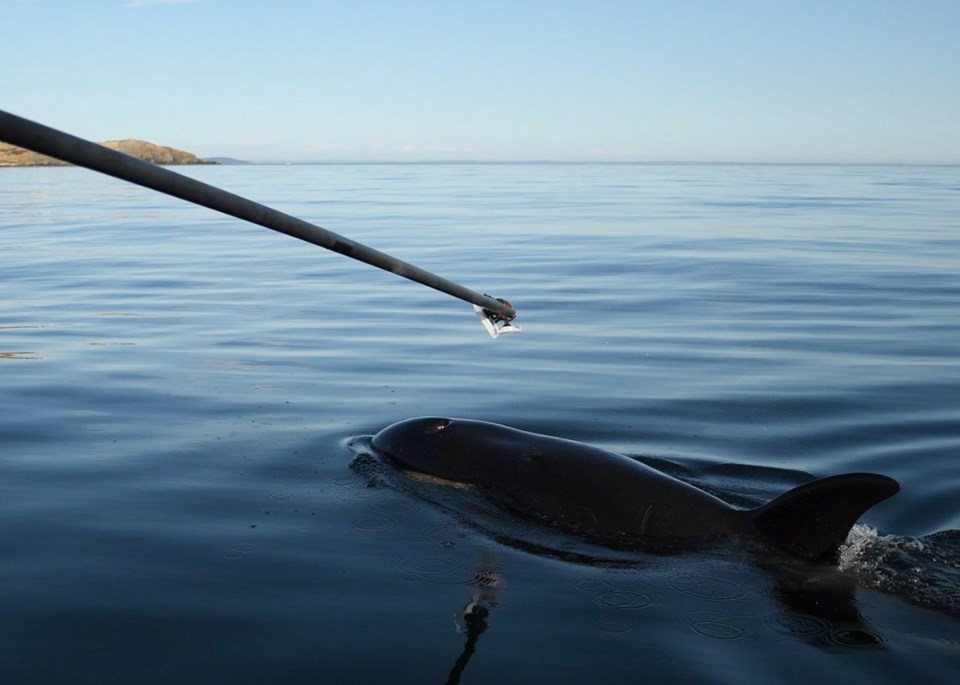Scientists used a dart to administer antibiotics to an ailing three-year-old killer whale Thursday, U.S. officials reported.
The National Oceanic and Atmospheric Administration announced late Thursday that response teams spotted J50, also known as Scarlet, and the rest of her pod of southern resident killer whales in Canadian waters and followed them into the U.S. near San Juan Island.
“While very skinny and small, J50/Scarlet kept up well with her mother and siblings,” NOAA stated on its website.
“Vancouver Aquarium’s veterinarian and the team conducted a visual assessment, obtained a breath sample that will help assess any infection, and administered antibiotics through a dart.”
The agency said researchers will continue to monitor the whale and may, in future, try feeding her live chinook salmon laced with medication.
Vancouver Aquarium confirmed in a separate post that its head veterinarian, Dr. Martin Haulena, was with the response teams Thursday.
Canada’s Department of Fisheries and Oceans stated on Twitter that it was “proud to take part in this collaborative effort to help ailing” J50.
Scientists on both sides of the border have become increasingly concerned about J50’s emaciated state in recent weeks and fear she could die, dealing yet another blow to the declining population of 75 southern resident killer whales. DFO officials have been working closely with their counterparts at the NOAA to develop a rescue plan.
DFO researchers have spotted J50 and her mother, J16, in recent days off the west coast of Vancouver Island and in U.S. waters off the Olympic Peninsula northwest of Neah Bay, Washington.
Brad Hanson, a U.S. research biologist, said the whales were too far out to sea previously for the treatment and assessment team to reach them from Friday Harbor in the San Juan Islands.
“It’s not uncommon for [the whales] to split their time between the outer coast and inland waters,” he said. “The challenge for us is that it’s about an 80-mile run from Friday Harbor out there in our boats.”
Heavy fog, wind and small-craft warnings posed additional challenges, he said. “So we’ve been standing by here, hoping that the southern residents will come back in.”
Hanson said the American team required fairly calm weather in order to get close enough to J50 to collect a breath sample.
“For close approaches, what we’re needing to try to do is to match course and speed of the animals and then very slowly and cautiously move in so we don’t disturb them,” he said.
In order to get breath samples, the scientists use a six-metre carbon-fibre pole with petri dishes on the end. “So we basically have to get within five metres of the whale,” Hanson said.
Depending on the conditions, the team could gather samples and treat J50 with antibiotics on the same day, he said.
Meanwhile, DFO researchers confirmed Wednesday that J35 was still carrying her dead calf more than two weeks since it died shortly after being born on July 24.
U.S. and Canadian officials acknowledged Thursday that they’re concerned that J35’s apparent grieving process could prevent her from foraging, but they have no plans to intervene at this point to remove the dead calf.
“I certainly think that the duration of carrying the calf is unprecedented,” said DFO scientist Sheila Thornton. “But there are many species who do undertake this sort of behaviour, where, if a young has failed to survive, they will carry the carcass.
“You can look at as mourning behaviour; there’s a lot of different theories out there. It’s very difficult to say, but, certainly, they’re very intelligent animals and the loss of this animal is quite profound for both the matriline and I think for everyone who witnesses this.”



